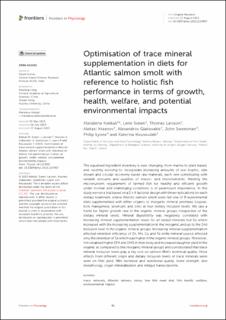| dc.contributor.author | Kokkali, Marialena | |
| dc.contributor.author | Sveen, Lene | |
| dc.contributor.author | Larsson, Thomas | |
| dc.contributor.author | Krasnov, Aleksei | |
| dc.contributor.author | Giakovakis, Alexandros | |
| dc.contributor.author | Sweetman, John | |
| dc.contributor.author | Lyons, Philip | |
| dc.contributor.author | Kousoulaki, Katerina | |
| dc.date.accessioned | 2023-09-04T10:58:39Z | |
| dc.date.available | 2023-09-04T10:58:39Z | |
| dc.date.created | 2023-09-01T12:25:22Z | |
| dc.date.issued | 2023 | |
| dc.identifier.citation | Frontiers in Physiology. 2023, 14 1-20. | |
| dc.identifier.issn | 1664-042X | |
| dc.identifier.uri | https://hdl.handle.net/11250/3087289 | |
| dc.description.abstract | The aquafeed ingredient inventory is ever changing, from marine to plant based, and recently evolving to incorporate increasing amounts of low trophic, side stream and circular economy based raw materials, each one contributing with variable amounts and qualities of macro- and micronutrients. Meeting the micronutrient requirement of farmed fish for healthy and efficient growth under normal and challenging conditions is of paramount importance. In this study we run a trial based on a 2 × 4 factorial design with three replications for each dietary treatment, where Atlantic salmon smolt were fed one of 8 experimental diets supplemented with either organic or inorganic mineral premixes (copper, iron, manganese, selenium, and zinc) at four dietary inclusion levels. We saw a trend for higher growth rate in the organic mineral groups irrespective of the dietary mineral levels. Mineral digestibility was negatively correlated with increasing mineral supplementation levels for all tested minerals but Se which increased with the increasing supplementation in the inorganic and up to the 2nd inclusion level in the organic mineral groups. Increasing mineral supplementation affected retention efficiency of Zn, Mn, Cu and Fe while mineral source affected only the retention of Se which was higher in the organic mineral groups. Moreover, fish obtained higher EPA and DHA in their body and increased slaughter yield in the organic as compared to the inorganic mineral groups and corroborated that trace mineral inclusion levels play a key role on salmon fillet’s technical quality. More effects from different origin and dietary inclusion levels of trace minerals were seen on fillet yield, fillet technical and nutritional quality, bone strength, skin morphology, organ mineralization and midgut transcriptome. | |
| dc.language.iso | eng | |
| dc.title | Optimisation of trace mineral supplementation in diets for Atlantic salmon smolt with reference to holistic fish performance in terms of growth, health, welfare, and potential environmental impacts | |
| dc.title.alternative | Optimisation of trace mineral supplementation in diets for Atlantic salmon smolt with reference to holistic fish performance in terms of growth, health, welfare, and potential environmental impacts | |
| dc.type | Peer reviewed | |
| dc.type | Journal article | |
| dc.description.version | publishedVersion | |
| dc.source.pagenumber | 1-20 | |
| dc.source.volume | 14 | |
| dc.source.journal | Frontiers in Physiology | |
| dc.identifier.doi | 10.3389/fphys.2023.1214987 | |
| dc.identifier.cristin | 2171653 | |
| cristin.ispublished | true | |
| cristin.fulltext | original | |
| cristin.qualitycode | 1 | |
